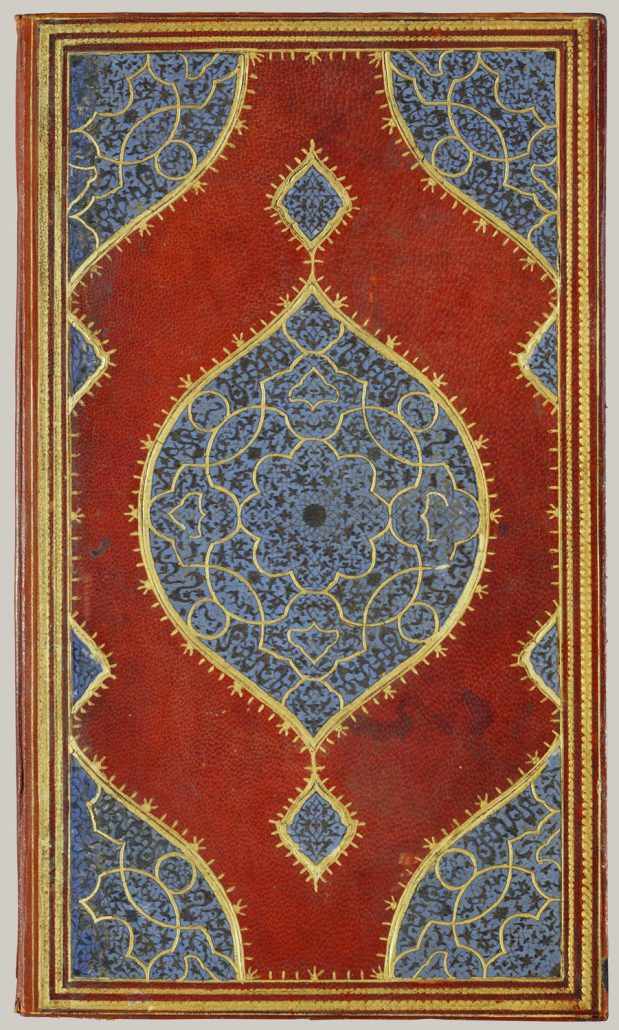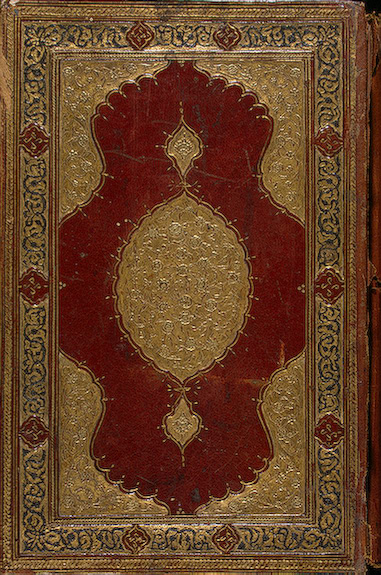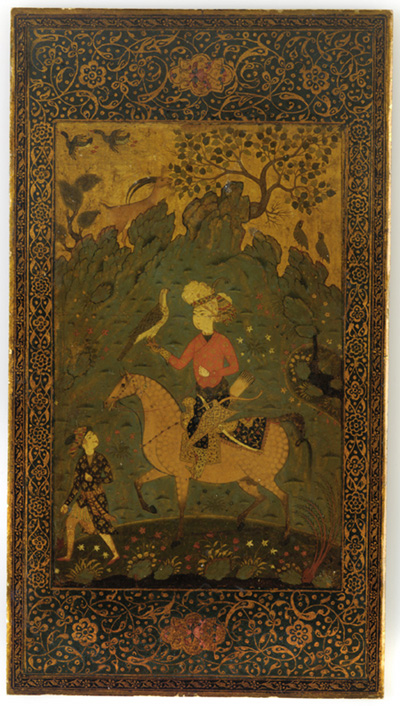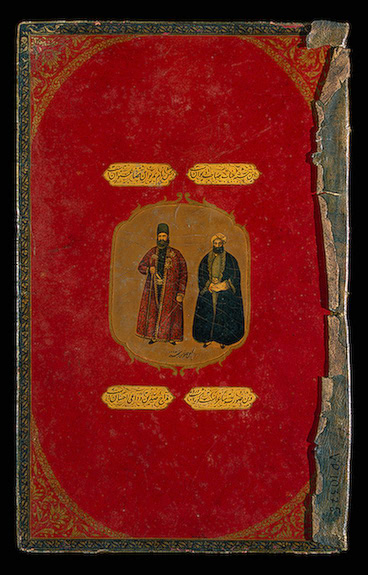The article below “Bookbinding” written by Duncan Haldane was originally published in the Encyclopedia Iranica on December 15, 1989 and last Updated on December 15, 1989. This article is also available in print (Vol. IV, Fasc. 4, pp. 363-365). Kindly note that the images and accompanying descriptions below do not appear in the original Encyclopedia Iranica posting.
=========================================================
Bookbinding (tajlīd, ṣaḥḥāfī) in Iran at first followed the pattern of previous Near Eastern book covers, but subsequently Persian craftsmen developed new types reflecting the luxury and refinement of courtly life. The edges of traditional bookbindings from the Islamic world are even with the text block, and the spine is always flat, without raised bands. A flap (lesān) attached to the rear cover folds over the text block to protect its edge and is tucked under the front cover. In Iran the leather most commonly used was goatskin, which had traditionally been tanned by means of immersion in a solution of ground-up plant materials. One of several technical innovations credited to Persian craftsmen, however, is mineral tanning, which involved soaking the skins in a solution of potash alum at a temperature between 20Xᵛ and 30Xᵛ C. Leather produced by this method is very soft and white. Designs were applied by means of blind tooling, in which simple tools were used to mark on slightly dampened leather.
Very few Persian bookbindings survive from the 8th/14th century or earlier. Among them is the binding of the Manāfeʿ al-ḥayawān (M. 500) in the Pierpont Morgan Library in New York, which was produced at Marāḡa at the end of the 7th/13th century (Ettinghausen); a fragmentary book cover said to have been found in the congregational mosque at Nāʾīn may also be of the 7th/13th century (Gratzl, 1938, p. 1976, pl. 951A). At this early stage in Persian bookbinding, the arts of the book were at their peak in Egypt and the Arabic-speaking world, and their influence was much in evidence in Persia. It was not long, however, before Persian binders began to develop their own individual styles. At the beginning of the 15th century, when artistic leadership of the Islamic world moved eastward to Persia, new methods were introduced. At Herat in about 1420 Prince Bāysonḡor Mīrzā, minister at the court of his father, Šāhroḵ Mīrzā (807-50/1405-47), and a great bibliophile, founded an academy and library that were to have a significant impact on subsequent Persian bookbinding. At the academy, which lasted for just over one hundred years, craftsmen were trained in all the arts of the book. During this period there was considerable interchange among the major Persian cultural centers. For instance, at Herat a calligrapher called Jaʿfar Tabrīzī prepared reports for Bāysonḡor, in one of which (now in the Topkapı Sarayı in Istanbul), there are four references to the art of bookbinding (Aslanapa, 1979, p. 59). Some extraordinary technical advances were made during the Timurid period. More sophisticated stamping and elaborate forms of tooling with gold began to supersede blind tooling.

The Khamsa or Quintet of Nizami (Ilyas Abu Muhammad Nizam al-Din of Ganja, lived c. 1141–1217) currently housed at the Metropolitan Museum of Art (Source:Fateme Toorani in Pinterest). This was most likely bound in Shiraz, Iran sometime in 1509-1510.
There is a Persian binding dated 838/1434-35, now in the Chester Beatty Library, Dublin (CBL 5282), which has been estimated to have required 550,000 blind stamps and 43,000 gold stamps and to have taken about two years to complete (estimates first published by Martin, p. 29, and subsequently repeated many times, e.g., Gratzl, 1938, p. 1978; see pls. 954, 955A). Undoubtedly the number of stamps has been greatly overestimated, but there is no denying the extraordinary degree of workmanship, and technical skill involved in the manufacture of this binding. Another major development was a cutwork technique (monabbatkārī, as it was called by Dūst-Moḥammad, who wrote in 951/1544), in which intricate filigree patterns were cut out of leather. There is no technical evidence for how craftsmen were able to cut and paste such finely wrought patterns. The major characteristics of later Persian bookbinding became established during the Timurid period. The front and back covers were normally decorated with matching designs, but the interior faces were usually more elaborately decorated than the exterior faces. In the Timurid period the normal pattern for both faces was a central scalloped medallion in the center, echoed by four medallion segments in the corners. The medallions were frequently cut out of the leather and filled in either with paper or with leather filigree patterns. Although stamps of ovoid shape (toronja “citrus-shaped”) had been known before, they became especially popular among Timurid craftsmen, who developed them considerably. In addition to this basic style of binding, which endured throughout the Safavid period and even lingered on into the Qajar period, bookbinders at Herat introduced figural decoration as well. These designs usually consist of landscapes containing real and mythical animals, often of Far Eastern inspiration, reflecting the strong artistic connections that existed between China and theTimurid capital.

Book binding from 16th century CE Iran (Source: Jacques Safavi in Pinterest and Fateme Toorani in Pinterest).
With the establishment of the Safavid dynasty in the 10th/16th century, there was a cultural and political shift from Herat in the east of Tabrīz in the northwest and Shiraz in the south. One of the major changes in bookbinding technique involved the widespread application of a method of embossing that had been introduced at the end of the Timurid period. Whole designs were engraved on single metal plates, which were then pressed onto the leather; symmetrical designs, which were most often floral, were engraved on dies half the size of the binding surface. They were then impressed twice to form the complete design, often leaving a noticeable join across the middle of the cover. This kind of embossing was often combined with gilding; the dampened leather was covered with gold leaf before the hot metal plate was hammered or screwed down, thus simultaneously impressing and gilding the design. These embossed designs, which could be repeated on a large number of book covers, mark something of a decline in the craft of bookbinding. Hand craftsmanship became a rarity. In addition, instead of cutting filigree designs out of leather, craftsmen began to use paper, which was both cheaper and easier to handle, pasting it onto painted paper or sometimes silk or other material.

Persian book binding from Isfahan from the 17th century (Source: Jacques Safavi in Pinterest and Fateme Toorani in Pinterest).
In the 11th/17th century the art of binding in Persia declined still further, both technically and in design. Sometimes designs were painted directly onto the leather, rather than stamped, and fine filigree additions became rarer. Despite the general decline in Safavid book art, however, one major technique already known under the late Timurids (Aslanapa, pp. 63-64) was perfected by the craftsmen of the period. The earliest bindings of this sort were of leather, heavily chalked and primed for illumination; designs were then painted on and finished with several coats of protective varnish. As the paint flaked off the leather rather easily, papier-mâché boards became the material most commonly used. The surface was fixed with gypsum or chalk and polished, then given a layer of colorless varnish before the design was painted in water-based paints. When dry the painting was covered with several coats of transparent varnish to fix and protect the design. Opinions have differed as to whether these final coats were in fact varnish or lacquer of the kind known to have been used by the Chinese. The technique attained great popularity in the 10th/16th and 11/17th centuries in centers like Tabrīz and Isfahan (the Safavid capital after 1006/1598) and continued to play a significant part in the cultural life of the Qajar period. It was emulated by Ottoman and Indian craftsmen as well. It is not known whether this so-called “lacquer work” had been introduced by Chinese craftsmen or by Persian visitors to China who had returned with knowledge of it; it is clear from such bindings, however, that illuminators and miniature painters played as important a part as the binders. By the 11th/17th century, binding designs had become rather stiff and wooden compositions. During the Qajar period, particularly the reign of Fatḥ-ʿAlī Shah (1212-50/1797-1834), European influences and somewhat harsher colors came to predominate. Although some very fine bindings continued to be produced, they do not compare in quality with those of the 9th/15th and 10th/16th centuries.

Persian lacquered book binding from 1878 (Source: Jacques Safavi in Pinterest and Fateme Toorani in Pinterest).
As a general rule Persian bookbinders worked anonymously. In the Timurid period, however, the names of several binders are documented in Dūst-Moḥammad’sḤālāt-e honarvarān, a Persian account of calligraphers and book craftsmen of the 9th/15th and 10th/16th centuries (“Dūst Muhammad’s Account,” p. 185). This work includes a reference to Ostād Qewām-al-Dīn Tabrīzī, to whom the invention of cut-pattern, or filigree, work is ascribed. In a discussion of Shah Ṭahmāsb’s royal library, Dūst-Moḥammad refers to two 10th/16th-century binders, Kamāl-al-Dīn ʿAbd-al-Wahhāb (Ḵᵛāja Kākā) and Moḥsen. References to other names can be found in the work by C. Huart.
Bibliography
O. Aslanapa, “The Art of Bookbinding,” in B. Gray, ed., The Arts of the Book in Central Asia, Paris and London, 1979, pp. 58-91.
G. Bosch and J. Carswell, Islamic Bindings and Bookmaking, Chicago, 1981.
“Dūst Muhammad’s Account of Past and Present Painters,” in L. Binyon, J. V. S. Wilkinson, and B. Gray, Persian Miniature Painting, Oxford, 1933, repr. New York, 1971, pp. 183-91.
R. Ettinghausen, “The Covers of the Morgan Manafi Manuscript and Other Early Persian Book Bindings,” in Studies in Art and Literature for Belle da Costa Greene, ed. D. Miner, Princeton, 1954, pp. 459-73.
F. R. Martin, A History of Oriental Carpets Before 1800 I, Vienna, 1906.
E. Gratzl, “Book Covers,” in Survey of Persian Art, pp. 1975-94.
Idem, Islamische Bucheinbände des 14 bis 19 Jahrhunderts, Leipzig, 1924.
D. Haldane, Islamic Bookbinding, London, 1983.
T. Harrison, “A Persian Binding of the Fifteenth Century,” The Burlington Magazine 34, 1924, pp. 31-32.
C. Huart, Les calligraphes et les miniaturistes de l’Orient musulman, Paris, 1908.
A. Sakisian, “La reliure persane au XVe siècle sous les Timourides,” Revue de l’art ancien et moderne 66, 1934, pp. 145-68.
F. Sarre, Islamische Bucheinbände, Berlin, 1923.
W. Watson, ed., Lacquerwork in Asia and Beyond, Colloquies on Art and Archaeology in Asia 11, London, 1982.



